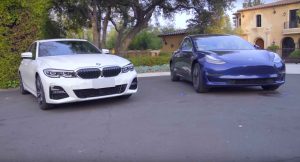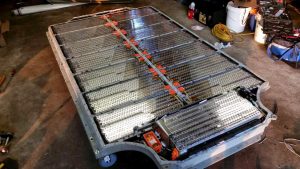The “greenest” vehicles on the road do not have plugs – nor batteries, either. Excepting the very small one that serves to start their engines. They have no electric motors, either – excepting the small ones that roll up their power windows and run their cooling fans.
They are old vehicles, like my 20-year-old truck – which I’ve not had to replace even once so far during those 20-years and counting. It is possible it will not require replacing for another 20, though it is certain I will have to replace some parts along the way.
But those parts entail less waste – of materials and energy – and so less, in terms of the “emissions” associated with the acquisition of materials and the making of them into parts, as opposed to making whole new cars. To say nothing of whole new battery packs, for electric cars – 1,000-plus pounds of raw materials each and lots of energy needed to make them.
And to power them.
What went into making an electric car takes years to unmake, in terms of “zero emissions” driving. Even relative to a new non-electric car, which does not use up as much in the way of raw material and so doesn’t involved the use of so much energy, which isn’t generated “cleanly” by windmill farms, either.
One revealing study of total emissions – if you consider carbon dioxide an “emission” – compared those produced during manufacture as well as issuing from the tailpipe (or not) of a Tesla Model 3 vs. a BMW 320i with a four cylinder gasoline-burning engine. A Tesla causes more than twice as many tons of carbon dioxide (5.2 of them, to be precise) to be “emitted” during the manufacturing process alone of its 1,000-plus pounds of battery pack than result from the oil-extraction/refining necessary to manufacture the BMW, itself.
And because the high-performance Tesla 3 is an energy hog – see that bit about the 1,000-plus pounds of battery pack it carries in order to deliver the high-performance it touts – it causes more total C02 to be “emitted” (21.3 tons of it) over its lifetime via electricity “burned” than does the four-cylinder-engined BMW (20 tons) via gas burned, because it (the BMW) is not a gas hog.
Modern gas engines such as the one in the BMW use remarkably little of it. This car comes close to achieving 40 MPG on the highway – and so emits remarkably little gas, whether the measure is hystericized C02 or the emissions of the gasses that can lead to such things as smog.
Of which there are meaningfully nil emanating from its tailpipe – or the tailpipes of modern gas-engined cars, generally. Which is why there is very little in the way of smog anymore. 
This being a function of the superior energy efficiency of cars like the BMW 3 in this example. Which is in part a function of its much lower curb weight.
A BMW 3 weighs about 500 pounds less than a Tesla 3 – which weighs more than two tons, half of one of those tons being the 1,000-plus pounds of battery pack it lugs around. Which weighs it down, creating a spiral of inefficiency that inevitably results in higher overall lifetime “emissions” of the carbon dioxide kind: 27.1 tons vs. 22.8 for the BMW.
But for really green, the most revealing vis-a-vis is between a new Tesla and something really old, like my 20-year-old truck.
It may “emit” more C02 than a new Tesla – at the tailpipe. But whatever it is “emitting” from there, it’s a great deal less than what was “emitted” via the making of that new Tesla, plus what will be emitted during the making of the new battery pack a new Tesla will require as a near-certainty long before it is 20-years-old.
Or even ten.
It is also unlikely the Tesla, itself, will last 20 years due to the inherently shorter life of electronic vs. mechanical things. How many cell phones last more than five years? And electric cars are very much like cell phones, just with much bigger – much more expensive – batteries.
Also: Most people who buy electric cars are not the kinds of people who keep their cars for 20-plus years or even ten. This being generally so because most of the people who buy electric cars are by default affluent people. Who else can afford to spend the $40k-plus it takes to buy the typical electric car, plus the peripherals – such as the alterations/updates to home electrical panels that are necessary in order to be capable of charging an EV at home faster than overnight?
Many EV owners also own a second car, for when their electric car isn’t available because it is charging or simply not practical (as for a long trip).
Two new cars equals how “green,” exactly?
Not many affluent people drive around in 20-year-old cars, much less 20-year-old trucks. They tend to favor new cars, serially. They want the latest thing. They want “technology” and “luxury-sport,” both inherently ephemeral since “technology” changes quickly and that which is ne plus ultra today, inside a car, is often old hat tomorrow.
They are, accordingly, the demographic most likely to change out what they have for something new – electric or not – as often as every three or four years. This is extremely un-“green,” if you obsess about such pious (and fatuous) hysterias.
I do not.
Instead, I continue to drive my old truck – which consumes next to no raw materials because it rarely needs new parts and those it does need are small things that don’t require any kids in the Congo to claw the raw materials out of mines, using their hands.
How long would a Tesla have to “emit” zero before it caught up to the total emissions I haven’t “emitted” by not buying anything new for 20-plus years? Shouldn’t that be incentivized?
Maybe people who are responsible enough to not buy a new anything for 20-plus years ought to get a tax deduction. Or at least, be able to use those special lanes they set aside for “zero emissions” vehicles, which aren’t.
. . .
Got a question about cars, bikes or anything else? Click on the “ask Eric” link and send ’em in! Or email me directly at [email protected] if the @!** “ask Eric” button doesn’t work!
If you like what you’ve found here please consider supporting EPautos.
We depend on you to keep the wheels turning!
Our donate button is here.
If you prefer not to use PayPal, our mailing address is:
EPautos
721 Hummingbird Lane SE
Copper Hill, VA 24079
PS: Get an EPautos magnet or sticker or coaster in return for a $20 or more one-time donation or a $10 or more monthly recurring donation. (Please be sure to tell us you want a magnet or sticker or coaster – and also, provide an address, so we know where to mail the thing!)
My eBook about car buying (new and used) is also available for your favorite price – free! Click here. If that fails, email me at [email protected] and I will send you a copy directly!












Love this article.
I have had six vehicles since 1980. I still have three of those six. One was destroyed in a rear-ender. One I traded in. One I gave to my little brother who still drives it [95 Saturn SL1 5M].
EV or half baked new 3 cyl ICE pulling 3600 lbs of plastic, electronic and saaaafety gimmicks and bloat? For the long haul?
I’ll keep what I’ve got: 59, 36 and 17 year old they may be.
Anyone who has income of 30,000 USD per year is in the top ten percent of the global population. IOW, 790,000,000 people make more than 30 grand each year. Anyhow, that is what Jordan Peterson claimed in an interview.
If you have a car, you are an over-consumer.
Criteria defining an over-consumer:
“Travel by car and air
Eat high fat, high calory meat-based diets
Drink bottled water and soft drinks
Use throw-away products and discard substantial wastes
Live in spacious, climate controlled, single family residences
Maintain image conscious”
The rest of the world’s inhabitants are sustainers and marginals. Where most over-consumers are headed, you’ll just be able to get by and not much more. Don’t think of it all as a problem, you’re the problem that needs a solution. All according the the edicts of the WEF, all going according to plan.
If you earned more than 7500 USD in 1995 estimates, you are an over-consumer. There are probably 2.0 billion people whose lives need an adjustment, less is more. Klouse knows how to get’er done.
The 500 billionaires on the planet don’t like over-consumption and that means anyone eating a healthy diet, makes you the target. Bill Gates is one of those evil, wicked, mean and nasty billionaires, Klouse is another. They know how to make a new and better world by building back better, they have the means to remove your car from the roads by just pricing fuels at a price only some will be able to afford. Your existence can’t depend upon private transportation, it’s going to be a thing of the past.
Electric cars are not going to run forever, after yours is toast, not too early as in self-immolation, but the dead battery, there will be no more private transportation for former over-consumers.
100,000,000 rich who always speak from their toothless wonders will do all of the decision making, the stakeholders of responsibility will be in command, you’ll follow orders. You’ll have nothing and you will be happy to follow orders. That’s an order! Well, for the 400,000,000 wretches left to live a hell on earth.
People don’t need firearms to harvest animals, they’ll eat bugs and enjoy it.
Cheers!
I filled up my 1993 Geo Metro today and it got 54 mpg.
My 30 year old car gets better mpg than a Prius or Civic hybrid.
I paid $500 for it a few years ago, and yes it is a dated and cheaply built car – but no one is laughing now that gas is over $5/gallon. One reason the Metro gets superior mpg is that it has a Suzuki G10 engine – a 1.0 liter 3 banger. Another is that the car is extremely light, it only weighs 1620 lbs (curb weight 2dr).
https://en.wikipedia.org/wiki/Suzuki_G_engine
Since is burns less fuel it puts out less CO2. Not many cars can beat a Geo Metro for economy or least carbon emissions.
Of course CO2 is NOT warming the planet, it can’t do that, it is a trace gas that follows earths temperatures up and down, CO2 has never warmed the planet. CO2 driven temperature change is a monumental hoax.
This is not conjecture, scientists have drilled ice cores and determined past atmospheric conditions, as the ice has tiny air bubbles, and they measure past CO2 vs. temp.
http://www.stallinga.org/Climate/GreenhouseGases.html
Al Gore has it wrong, CO2 FOLLOWS temperature, it does not force temperature. Oops.
The problem with electric cars is that they are being sustained in a large part by a media and political driven hoax. People actually believe the crap on TV and in the New York Times. Many people are very stupid, I see them everyday wearing masks, not sure what for this time.
I did an experiment a year ago in my Geo Metro, I drove it ultra slow to see if I could achieve the ultra high mpg at low speeds based on the findings of this bright young man who runs https://metrompg.com/.
He has a newer metro, one with OBD2 which was mandated in 1996. (My metro is OBD1) He drove in 5th gear at different speeds with a OBD2 Scan Gauge – which has instant mpg readout. This is what he found in chart form:
https://metrompg.com/posts/speed-vs-mpg.htm
https://metrompg.com/zoom_image.htm?H=391&W=519&ZoomFile=mpg%2Dvs%2Dspeed%2Dchart%2Dz%2Egif&Caption=&title=Blackfly%20graph
He found that at freeway speeds you get the EPA mpg rating.
But if you slow down the mpg goes way the hell up (due to lower air drag). In 5th gear at 35 mpg a Geo Metro can get nearly 80 mpg.
I did three test runs to check to see if it was true. I filled up my tank and drove from Medford Oregon to Grants Pass on Hwy 99 and back and filled up again. I got about 74 mpg each time.
If you search images for your car “mpg vs. mph” you might find one that someone did. Or you can get a scan gauge gadget and go test it yourself.
Obviously if someone could improve the Cd of a Geo Metro (Cd = .32 – .34) then such high fuel economy could be achieved at freeway speeds. For instance the 2000 Honda Insight has a Cd (coefficient of drag) of 0.19 – .25.
https://ecomodder.com/wiki/Vehicle_Coefficient_of_Drag_List
If a little car was built out of aluminum body and doors then it might be possible to have a curb weight below 1500 lbs. So in my mind it is very possible to build cars that get 70 mpg and in Germany and Japan they are doing so.
EV’s pollute more
NOTE: The biggest pollutant emitted from new cars because they have so low emissions are from tires wearing out while driving, tire particles.
ATTENTION: Electric cars weigh 30% more than gas powered cars so have higher tire wear, so EV’s pollute more.
EV highway driving consumption
The advertised range that many manufacturers brag about is the average or city driving figure. However, the highway range is much smaller, sometimes up to 50 percent less.
At WOT the range is 80% less, beware…..
operating Li-ion batteries outside the safety zone (i.e. 20%–80%) state of charge, a loss in conductivity can be observed
You can only use 60% of the advertised range (between the 20% and 80% charge), , in cold weather subtract up to 50% more, so what is the real world range?
ATTENTION: Only 5% of electric car lithium fire bomb batteries are recycled, a huge pollution problem. there is a $4500.00 recycling fee, so lots of them will get thrown in the bush….
In their entire life cycle including manufacturing, electric cars in total pollute far more than gas powered cars, people don’t seem to understand that the vast majority of a car’s carbon footprint is made during manufacture and scrapping. Running the car, not so much. EV’s pollute far more,
Most electric cars are designed as performance cars so they use far more energy and resources than they should. (the government regulations don’t allow the manufacture of small light electric cars which would make more sense, china does).
Recharging costs:
The grid can’t handle large numbers of electric cars recharging, if all cars are electric the grid capacity has to be increased 30x. There is already power shortages, blackouts in many countries with electricity costs rapidly rising, when electricity prices go up 400% your old ice vehicle will look cheap to run.
Open pit lithium mining for battery manufacture, often done with child slave labour, is worse then tar sands mining.
ATTENTION: EV’s can’t replace ICV’s because………global capacity for the materials for EV batteries can’t replace even 3% of fossil fuel vehicles.
Electric cars are expensive, they are only for the rich, but they are heavily subsidized by the government with taxpayer’s money, including taxes from the poor, the poor subsidizing the rich. the poor can walk. electric cars, toys for the rich.
NOTE: The first people to buy electric cars were the most sold on the idea, the biggest believers, 20% of them are switching back to ice powered cars because of the inconvenience factor, the charging time hassle.
Another problem EV shares with new ice powered vehicles: Electronic components have a limited life, even if you do not use them. It’s the nature of the P-N junction that forms a transistor.
During the first three months of ownership, EVs were 2.3 times as expensive to service as gasoline-powered cars. At the 12-month mark, repair costs were about 1.6 times what owners of gas-powered cars paid.
It’s Not Parts. It’s Labor
Electric cars depreciate over two times faster than their internal combustion engine counterparts, a serious black mark when it comes to tallying up your actual yearly cost to run your vehicle!
So the new electric vehicles like the new computerized ice vehicles will have a limited lifespan, when these electronics fail the car will be scrap, too expensive to fix, more recycling and waste. Only buy cars with no computers.
After 10 years in a tesla the $22,000.00 battery has to be replaced, (plus there is also a $4500.00 recycling fee), the residual value of the car is around $23,000.00 after ten years, the only solution is to scrap the car.
One tesla owner used dynamite:
Watch a Tesla owner blow up his Model S with 66 pounds of dynamite instead of paying $22,000 to repair it
https://www.businessinsider.com/tesla-owner-blows-up-car-instead-paying-repair-battery-video-2021-12?op=1
A 1913 Bugatti type 22 is 108 years old and daily driven. A Tesla is scrap after 10 years.
But mechanical systems, like Jay Leno’s 1832 steam engine can last for centuries, get a steam powered car, they run on wood.
Steam powered cars have the same advantage as electric cars, instant torque.
A new steam engine is over 50% efficient, an EV is 25% efficient, if it is very cold out it is 12% efficient.
Howard Hughes’ 1925 Doble E20 went 0 to 75 mph in just 5 seconds, with its engine turning over at less than 1,000 rpm, a steam engine is a very low rpm engine.
The tesla plaid motors runs at up to 19,000 rpm, that sounds dangerous, will wear out quickly, car electric motors are too high rpm. The steam engine goes 600,000 miles without an overhaul. After 100,000 miles the tesla battery is dead so it is worthless, scrapped, at 19,000 rpm the motors are probably gone too..
Howard Hughes’ 1925 Doble E20 top speed was 133 mph in 1925, with today’s technology the steam powered car might be quicker then anything.
The steam engine goes 600,000 miles without an overhaul, this better then most gas ice engines. In a tesla the battery goes in 100,000 miles so in 600,000 miles you go through 6 teslas, a huge waste of resources….
That my 2003 S-10 can be a greenest vehicle never occurred to me. Guilt pacified; defense enabled.
Eric… Thanks for your greenest posting ever!
EV news this afternoon: Tesla files for 3:1 stock split.
Instead of roughly one billion shares outstanding at $696 each, after the split there’ll be around three billion shares at $232 each, leaving total market cap the same.
Why now? Elon knows that share splits typically juice the stock price, even though the value underlying the shares is unchanged.
Air is audibly hissing out of the Bubble now. Elon’s net worth may get a boost on Monday. But next year is what he should worry about.
And he can’t do jack about it, as the auto market crashes under the triple hammer of higher rate loans, rising fuel prices, and tapped-out buyers hunkering down for a horrorshow recession.
Tesla is valued at 710 USD. At 696 USD split to the 232 USD number is pure bait. Much easier to fish in three small suckers compared to fishing in one big one. Musk just gave himself three times as many shares and institutions are more than happy to short the another two shares stock on the options board. You can sell if there are buyers, no buyers, you have to hang on to your shares until there is one.
If you want your owned shares to be traded on the NYSE, sell, there has to be a buyer. Only so many shares sold of the total outstanding shares. You can call in all of the shares and go private. It happens, you have to sell what you own. A private equity buys all of the shares, owns all of the calls, the right to buy.
Nissan is $8.26 per share and I see a lot more Nissans than Teslas. If there is a buy on the stock exchange, it is Nissan. Sell Tesla, buy Nissan. Nissan is down a good 14 dollars from its all time high. Just an opinion from some local yokel on the outside looking in. All the way from The Pale.
I don’t own Tesla nor Nissan. Energy stocks is where it’s at.
Mere musings from another over-consumer, time to drink more beer .
Time for Klouse to eat another meal of bugs. Makes him happy.
Banning ice powered vehicles to be replaced with EV’s that use twice as much fuel (25 mpg), = insanity.
travelling 100 miles in an average EV uses 1.03 gallons equivalent of fuel = 34.7 kwh of electricity that is the net amount, but….at the power plant 4 gallons of fuel were burnt to get a net 1 gallon of fuel equivalent 34.7 kwh used by the EV.
travelling 100 miles in an average EV uses 1.03 gallons equivalent of fuel = 34.7 kwh of electricity @ $0.40 per kwh = $13.88, back at the power plant 4 gallons were burnt to get the net 34.7 kwh of electricity. NOTE: 4 gallons were burnt to go 100 miles.
There is an additional cost for the EV owner: the tesla $22,000 battery is used up, worn out in 100,000 miles. this works out to $22.00 per 100 miles it is costing you for the battery. Total cost: $13.88 plus $22.00 = $35.88
EV owner uses 4 gallons to go 100 miles, that is 25 mpg, lots of ice cars get better fuel economy.
travelling 100 miles in a 50 mpg diesel uses 2 gallons of fuel @ $4.00 per gallon = $8.00 and it has a huge range……
Should be still selling these:
the all-new 2014 Volkswagen Golf BlueMotion diesel, capable of a claimed 88.3 mpg imperial, or 73.5 mpg U.S.
should be driving these cars:
Model HP Avg. cons l/100km mpg U.S.
Fiat 500 1.3 JTD Multijet 16V Pop DPF 75 4.2 56
VW Golf 1.6 TDI BlueMotion DPF 105 4.1 57
Skoda Fabia 1.4 TDI GreenLine DPF 80 4.1 57
Opel Corsa 1.3 CDTI ecoFlex CO2 Pack DPF 75 4.1 57
Audi A3 1.6 TDI Attraction DPF 105 4.1 57
Toyota iQ 1.4 D-4D DPF 90 4.0 59
Renault Twingo 1.5 dCi Rip Curl 84 4.0 59
Volvo S40 / V50 1.6D DRIVe Start/Stop DPF 109 3.9 60
Volvo C30 1.6D DRIVe Start/Stop DPF 109 3.9 60
Toyota Prius 1.8 Hybrid 136 3.9 60
Mini One D DPF 90 3.9 60
VW Polo 1.6 TDI BlueMotion 90 3.7 64
Seat Ibiza 1.4 TDI Ecomotive DPF 80 3.7 64
Ford Fiesta 1.6 TDCi ECOnetic DPF 90 3.7 64
smart fortwo coupé 0.8 cdi pure softip DPF 54 3.4 69
VW made a lightweight diesel hybrid that got almost 300 mpg, that was a better solution then EV’s, that get 25 mpg…lol….
Volkswagen XL1 Diesel-Hybrid 300 mpg highway…
https://www.hotcars.com/remembering-the-1liter-supercar/
There is yet another way in which EVs are less green.
EVs are heavy vehicles.
Heavy vehicles are less green for several reasons:
1. Heavy vehicles wear out their brakes and tires more and sooner. Witness how big rig tires are often recapped and leave “gators” on the road. Heavier vehicles need more new tires and brake jobs than lighter ones. Plus, brakes and tires create pollution when they are made, when they wear out, and when they are replaced.
2. Heavier vehicles wear out roads and bridges more and sooner. What’s the carbon footprint of resurfacing a mile of highway or city street, or even replacing a bridge? I don’t think any of the trucks, bulldozers, and graders are powered by electricity. I also don’t think that cement and asphalt plants or steel mills are zero emissions either.
3. Most of all, heavy vehicles simply take more energy, period, to move. It’s a matter of high school physics.
If we were really concerned with greener vehicles, we’d make them a lot lighter. And we can do it without remaking K-cars and Yugos, thanks to better manufacturing technology.
PS: EVs are also less green because they don’t last as long.
A K-car made with today’s state-of-the-art manufacturing and engine/drivetrain management technologies would likely well out-perform the original, and, in terms of actual purchasing power, be quite a bit CHEAPER than the original. But so would a latter-day Dodge Dart or VW Beetle.
When the curb weight of my otherwise ‘normie’ 2020 Ford (con)Fusion is more than, say, a 1973 Ford LTD sedan with a 351 Cleveland (‘335’ engine series), you know we’ve gone in the WRONG direction.
RE: point 3
I’ve noticed with large diesel trucks that past a certain point added weight doesn’t appear to hurt mpg much if any. My ’08 Hino 338 (24′ box van) gets 6 mpg at 19k (empty weight) or at 30k loaded. ~260 hp.
My old Freightliner would get 7+ mpg dragging around 70k loaded. ~450 hp.
Also have a ’98 F450 (7.3 Powerstroke) that weighs ~13.5k and only gets mid 8s for mpg.
Aerodynamics are likely a factor (none of the above are very ‘slippery’).
You know something that would be extraordinarily funny? Eric writing a piece extolling the virtues of hypermiling. Never happen, but with today’s gas prices, I think the time to complain about hypermilers is over.
I drive a 12-year-old, beat-up, Ford Escape that still averages 25 MPG with the driving I do (not too many Interstate miles for me). Maybe I should get a break, too.
Nothing wrong with hypermiling, a long as you aren’t making a nuisance of yourself.
The greenest of all vehicles is your feet. And it appears that’s where we are headed. The watermelons won’t be happy until we are all living in mud huts farming our half acre of beans with hand tools, if we are lucky enough to have them. Cost of production is completely ignored when challenging greenness. Back when cars had much more steel in them, it took more fuel to build one than it would use in its service life. With the 1000 pound plus batteries, and their short service life, we may be circling back to that.
The PTB will NOT, if they can help it, permit ANY demonstration of self-sufficiency. Why do you think PREPPERS are high on the corrupt FBI’s “Terrorist Watch” list? They’re on it b/c they spread information as to how to be SELF-SUFFICIENT, and, where possible, LIVE OFF THE GRID. That’s the LAST thing the control freaks running this once-great country from the “District of Criminals” want!
Maybe people who are responsible enough to not buy a new anything for 20-plus years ought to get a tax deduction. Or at least, be able to use those special lanes they set aside for “zero emissions” vehicles, which aren’t. – Eric.
Great idea Eric, we should get “carbon credits” like Elon does. That’s the only reason he got to be a billionaire, grifting money from taxpayers via Uncle’s ridiculous rule making. You have a 20 year old truck, I’ve got a 21 year old sedan; let’s say $1k/year for every year you keep it going beyond 10 years. Be nice to have the IRS cough up some $10,000 checks for us.
Mike, I understand what you guys are saying, but it would be even nicer if the IRS didn’t exist to divvy up and spend other people’s money in the first place.
…I only dream.
My brother & I were talking the other day about how we’re our father’s sons i.e. we drive ’em until the last trip they make is to the junkyard. I’m in my late 50s (dammit) and he’s in his early 60s. Over the years between the two of us we really haven’t owned that many cars bc we drive them until the wheels fall off.
Teen years:
Brother had a Ford F100 (which he’d kill to have back). I had my Vega station wagon.
Young men years:
Brother had a Ford Ranger. I had a Chevy Cavalier.
Middle age years – creeping up on ol’ farts of today:
Brother has a GMC Sierra. I have a GMC Sierra and a BMW x5 (which I’d love to be rid of).
Since 1978, he and I have had a total of 7 autos. All of which were/are very, very high mileage.
My daily drivers:
1985 – 2001: 1972 Chevelle
2000 – 2019: 1998 Ranger
2019 – present: 2008 Scion TC
The TC has the crappy Camry motor that starts burning oil at 75,000 miles. Toyota claims it is normal. It burns more oil in a month than the other 2 did in the 36 years total I had them.
Paging “Joe Biden” … CPI inflation just blew out to 8.6% annually, the highest since 1981.
But apparently, “Joe” knew this yesterday afternoon. Someone in the White House told a Fox News reporter Thursday afternoon that the CPI would come in hot.
And someone else, apparently “in the know,” relentlessly sold stocks yesterday afternoon, all the way to the closing bell.
How corrupt is America, anyway? Were “Joe Biden” and Nancy Pelosi literally selling America short yesterday, using illicit advance knowledge about a bad CPI report?
Ooh ooh, that smell … can’t you smell that smell?
Isn’t a standard car starter battery 95+% recycleable?
Who is attempting to recycle Tesla batteries? Someone must be up and running by now.
If it is Tesla itself, can someone point to a place on the Internet with details on the facility?
Hi Roscoe,
Yes, a standard car battery is recyclable. It is also lead-acid and much smaller, a fraction of the size and weight of the typical EV lithium battery pack, which typically spans the length and width of an EV’s floorpan and weighs 1,000-plus pounds.
Most “new” batteries, in fact, ARE made with “recycled” materials. The CASES are saved, checked for cracks or abrasions that render them unusable, cleaned, and NEW lead plates and solution are put in. It should be obvious how easily, via a reverse electroplating process, the lead plates from depleted lead-acid batteries can be renewed and made into fresh plates again.
And still the damn things are MORE expensive than ever. My #2 son had to put one in his 2006 Dodge Dakota this past week, cost him $200 from O’Reilly’s, a Group 34 type, I think, i.e., very COMMON. Besides the obvious increased costs of shipping the heavy mothers, likely it’s the cost of environmental compliance in manufacturing that’s driven the cost up. Never mind that I’ll bet it came from some “Maquiladora” in Matamoros, Tamaulipas, MX.
hi Eric
DIY electric car runs 200 miles on old lead-acid batteries, which are 100% green…..
The rise in demand for clean vehicles has not only tempted automakers to rollout next-gen electric vehicles, but has also encouraged several eco-conscious individuals to use their skills to create low-cost electric rides. David Cloud is one such individual who has spent $3000 in converting a 1997 Geo Metro to run on an electric engine fueled by old lead acid batteries.
The vehicle is powered by 8” ADC motors that are included on each rear wheel and are powered by old 12V lead-acid batteries. The vehicle has a top speed of 72mph and can hit 60mph in 18 seconds, with a range of about 200 miles.
Lead acid batteries are 100% recycled so are green. Only 5% of lithium batteries are recycled, plus there is a rumored $4500 recycling fee, so lots will get thrown ion the woods…..
https://ecofriend.com/diy-electric-car-runs-200-miles-on-old-lead-acid-batteries.html
‘Not many affluent people drive around in 20-year-old cars, much less 20-year-old trucks.’ — Eric
One is reminded of the late Steve Jobs, who serially leased new vehicles for 6 months so he could always have a temporary plate … and keep a low profile against autograph seekers and stalkers. Female stalkers are the scariest.
Meanwhile, two other bent billionaires are having a spat over their green credentials:
‘Tesla CEO Elon Musk has recently cast doubts on Gates’ goodwill in fighting climate change, given the latter’s short position against the electric carmaker.
“I give a lot more money to climate change than Elon or anyone else. I give a lot of philanthropic dollars, I back companies,” Gates said in his recent talk. “Electric cars are about 16 percent of emissions, so we also need to solve that other 84 percent.”
“But somebody shorting the stock doesn’t slow him down or hurt [Musk] in any way,” the billionaire argued, without denying a previously-confirmed half-billion-dollar bet against the automaker, which would now require up to $2 billion to close out. — ZH
Oofy … shorting half a billion of TSLA and having to buy it back for two billion would sure dent my budget.
Or ol’ Bill can just wait for time to take care of Tesla.
What bubbles up must slide back down.
Jobs may have had that problem back when it was possible to look up one’s address from CA DMV files, until the murder of actress Rebecca Schaeffer in ’89. I can see why he’d have to go to those types of measures to “fly under the radar”.
OT: Five Judenräte automakers tell the Feds they want California emissions rules.
https://arstechnica.com/cars/2022/06/ford-bmw-honda-volkswagen-and-volvo-defend-california-emissions-rules/
Of course they do. That way they can just “cost plus” the expense on to the customer. And helps keep design costs down too. Ever wonder why every vehicle has a 2.0 L turbo engine? Because the EU demands an indulgence if you want anything larger. Someone did an engineering study to figure out the “ideal” cylinder volume, and all manufacturers just use that design and just add or subtract cylinders as wanted. Little to no difference in engines, because it’s mature technology. The biggest innovation in the last 10 years has been the removal of the dip stick. Why bother with something exciting or interesting? Better to just hard codify engine design and move on.
I for one am shocked that the big selling point – save the world through unicorn farts – is not quite as advertised.
The government would never lie to us or push something on us that wasn’t for our own good. After all, the government is comprised of the smartest, most ethical, and best among us.
EVs are trash…plain and simple. This is new world order bullshit and they can all go to hell.
It reeks of the old world order.
You know, the one that got fired at the end of the 18th century, and never quite completely went away.